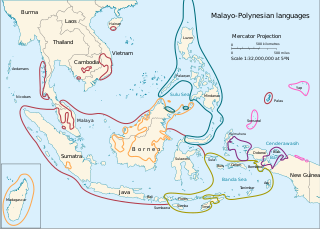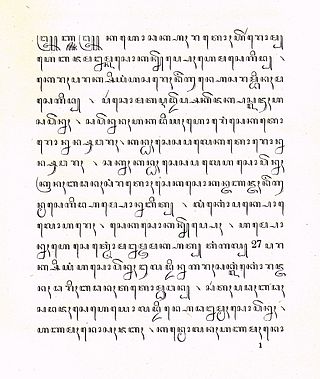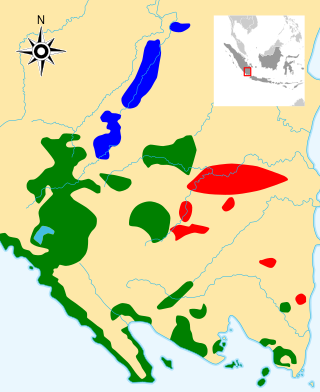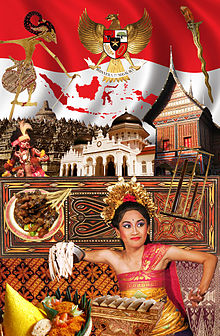
Sumatra is one of the Sunda Islands of western Indonesia. It is the largest island that is fully within Indonesian territory, as well as the sixth-largest island in the world at 475,807.63 km2 (182,812 mi.2), including adjacent islands such as the Simeulue, Nias, Mentawai, Enggano, Riau Islands, Bangka Belitung and Krakatoa archipelago.

The Malayo-Polynesian languages are a subgroup of the Austronesian languages, with approximately 385.5 million speakers. The Malayo-Polynesian languages are spoken by the Austronesian peoples outside of Taiwan, in the island nations of Southeast Asia and the Pacific Ocean, with a smaller number in continental Asia in the areas near the Malay Peninsula, with Cambodia, Vietnam and the Chinese island Hainan as the northwest geographic outlier. Malagasy, spoken in the island of Madagascar off the eastern coast of Africa in the Indian Ocean, is the furthest western outlier.

Malay is an Austronesian language that is an official language of Brunei, Indonesia, Malaysia, and Singapore, and that is also spoken in East Timor and parts of Thailand. Altogether, it is spoken by 290 million people across Maritime Southeast Asia.

Sundanese is a Malayo-Polynesian language spoken by the Sundanese. It has approximately 32 million native speakers in the western third of Java; they represent about 15% of Indonesia's total population.

Javanese is a Malayo-Polynesian language spoken by the Javanese people from the central and eastern parts of the island of Java, Indonesia. There are also pockets of Javanese speakers on the northern coast of western Java. It is the native language of more than 68 million people.

Madurese is a language of the Madurese people, native to the Madura Island and Eastern Java, Indonesia; it is also spoken by migrants to other parts of Indonesia, namely the eastern salient of Java, the Masalembu Islands and even some on Kalimantan. It was traditionally written in the Javanese script, but the Latin script and the Pegon script is now more commonly used. The number of speakers, though shrinking, is estimated to be 10-13 million, making it one of the most widely spoken languages in the country. Bawean Madurese, which is a dialect of Madurese, is also spoken by Baweanese descendants in Malaysia and Singapore.

Minangkabau is an Austronesian language spoken by the Minangkabau of West Sumatra, the western part of Riau, South Aceh Regency, the northern part of Bengkulu and Jambi, also in several cities throughout Indonesia by migrated Minangkabau. The language is also a lingua franca along the western coastal region of the province of North Sumatra, and is even used in parts of Aceh, where the language is called Aneuk Jamee.
In addition to its classical and modern literary form, Malay had various regional dialects established after the rise of the Srivijaya empire in Sumatra, Indonesia. Also, Malay spread through interethnic contact and trade across the south East Asia Archipelago as far as the Philippines. That contact resulted in a lingua franca that was called Bazaar Malay or low Malay and in Malay Melayu Pasar. It is generally believed that Bazaar Malay was a pidgin, influenced by contact among Malay, Hokkien, Portuguese, and Dutch traders.

The Malayic languages are a branch of the Malayo-Polynesian subgroup of the Austronesian language family. The most prominent member is Malay, a pluricentric language given national status in Brunei and Singapore while also the basis for national standards Malaysian in Malaysia and Indonesian in Indonesia. The Malayic branch also includes local languages spoken by ethnic Malays, further several languages spoken by various other ethnic groups of Sumatra, Indonesia and Borneo even as far as Urak Lawoi in the southwestern coast of Thailand.
Betawi, also known as Betawi Malay, Jakartan Malay, or Batavian Malay, is the spoken language of the Betawi people in Jakarta, Indonesia. It is the native language of perhaps 5 million people; a precise number is difficult to determine due to the vague use of the name.

There are 1,340 recognised ethnic groups in Indonesia. The vast majority of those belong to the Austronesian peoples, with a sizeable minority being Melanesians. Indonesia has the world's largest number of Austronesians and Melanesians.

Lampung or Lampungic is an Austronesian language or dialect cluster with around 1.5 million native speakers, who primarily belong to the Lampung ethnic group of southern Sumatra, Indonesia. It is divided into two or three varieties: Lampung Api, Lampung Nyo, and Komering. The latter is sometimes included in Lampung Api, sometimes treated as an entirely separate language. Komering people see themselves as ethnically separate from, but related to, Lampung people.
Bengkulu Malay or Bengkulu is a Malayic language spoken on the Indonesian island of Sumatra, around the city of Bengkulu, in the rest of the Indonesian province of Bengkulu and in the Pesisir Barat Regency of Lampung Province. It is more closely related to other Malay variants in Sumatra such as Col, Jambi Malay and Palembang Malay as well Minangkabau spoken in neighbouring West Sumatra than to the Rejang language, which is also spoken in the province.

Malay Indonesians are ethnic Malays living throughout Indonesia. They are one of the indigenous peoples of the country. Indonesian, the national language of Indonesia, is a standardized form of Riau Malay. There were numerous kingdoms associated with the Indonesian Malays along with other ethnicities in what is now Indonesia, mainly on the islands of Borneo and Sumatra. These included Srivijaya, the Melayu Kingdom, Dharmasraya, the Sultanate of Deli, the Sultanate of Siak Sri Indrapura, the Riau-Lingga Sultanate, the Sultanate of Bulungan, Pontianak Sultanate, and the Sultanate of Sambas. The 2010 census states that there are 8 million Malays in Indonesia; this number comes from the classification of Malays in East Sumatra and the coast of Kalimantan which is recognized by the Indonesian government. This classification is different from the Malaysia and Singapore census which includes all ethnic Muslims from the Indonesian archipelago as Malays.

Acehnese or Achinese is an Austronesian language natively spoken by the Acehnese people in Aceh, Sumatra, Indonesia. This language is also spoken by Acehnese descendants in some parts of Malaysia like Yan, in Kedah. Acehnese is used as the co-official language in the province of Aceh, Indonesia. Besides Indonesian used as the official language.

Sembah is an Indonesian greeting and gesture of respect and reverence. While performing the sembah, one clasps their palms together solemnly in a prayer-like fashion called suhun or susuhun in Javanese; or menyusun jari sepuluh in Indonesian and Malay, placing them in front of their chest and moving the pressed palms up to their chin, or all the way up until their thumbs touch the tip of their nose, while bowing slightly. Any of these two forms are made depending on the status of the person greeted.

Komering is a Lampungic language spoken by the Komering people, an indigenous ethnic group native to Komering regions alongside the Komering River in South Sumatra, Indonesia.

Rejang people are an Austronesian ethnolinguistic group, native to the some parts of Bengkulu Province and South Sumatera Province in the southwestern part of Sumatera Island, Indonesia. They occupied some area in a cool mountain slopes of the Barisan mountain range in both sides of Bengkulu and South Sumatra. With approximately more than 1,3 million people, they form the largest ethnic group in Bengkulu Province. Rejang people predominantly live as a majority in 5 out 10 regencies and city of Bengkulu Province, while the rest of them who lives in South Sumatera resides at 7 villages in the district called as Bermani Ulu Rawas. The Rejangs are predominantly an Islam adherent group with small numbers following a religion other than Islam. According to research, Rejang people are the descendants of the Bukar-Sadong people who migrated from Northern Borneo (Sarawak).

The region comprising the other 21 provinces in Sumatra, Java, and Kalimantan is known as Western Indonesia.




















